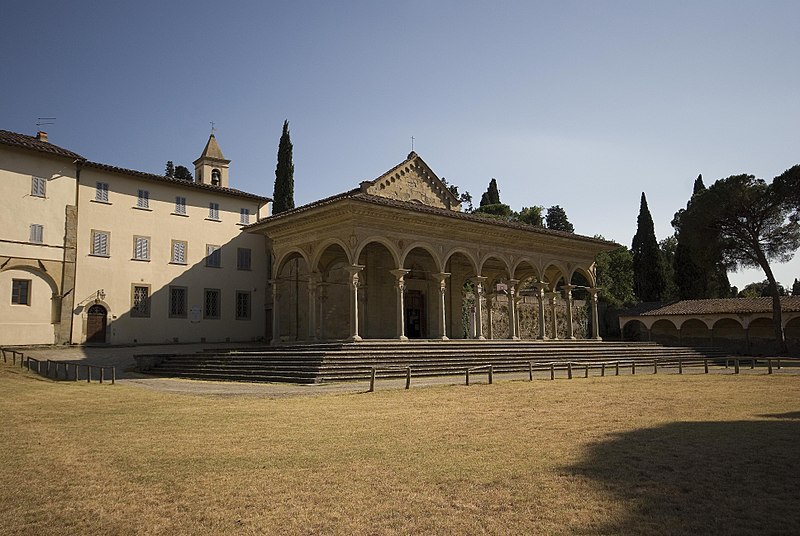Santa Maria delle Grazie: an ancient spring between myth and history
Santa Maria delle Grazie has its roots in the distant past, when the site was home to a sacred spring dedicated to the god Apollo, a symbol of healing and light. During the Etruscan-Roman period, the spring was a destination for rituals related to its therapeutic properties, attracting worshippers from all over the region.
Over time, the place took on the name Fons Tecta, continuing to be frequented even in the early Middle Ages for healing practices, particularly against childhood ills. However, with the rise of Christianity, the ancient pagan cult came into conflict with the new religion.
This conflict marked the beginning of a transformation, culminating with the arrival of St. Bernardine of Siena and the subsequent birth of the shrine as we know it today.
The Turning Point of St. Bernardine of Siena
In 1425, St. Bernardine of Siena arrived in Arezzo to preach during Lent and clashed with the deep-rooted traditions associated with the Fonte Tecta.
Despite his attempts to destroy it, he was thwarted by local noble families and forced to leave the city. He returned in 1428, determined to put an end to the pagan rites, and this time he succeeded, thanks to the support of a group of faithful armed with determination.
In place of the spring, St. Bernardino had an oratory built, a symbol of Christianity’s victory over ancient beliefs. In 1430, Parri di Spinello decorated the oratory with a fresco of “Our Lady of Mercy,” which became an icon of protection and faith for the people of Arezzo.
The construction of the shrine of Santa Maria delle Grazie
The growing influx of the faithful made the oratory built by St. Bernardino insufficient to accommodate all the devotees. Between 1435 and 1444, a new church was built, designed by Domenico del Fattore, which combined late Gothic and Renaissance elements.
The structure, with its single nave and cross vaults, represented an important architectural development for the time. After the canonization of St. Bernardine in 1450, a chapel dedicated to the saint was added on the right side of the church, further enriching the complex.
The church became not only an important place of worship but also a symbol of artistic and spiritual rebirth for Arezzo, reflecting the harmony between faith and architecture.
The loggia of Benedetto da Maiano: Renaissance elegance
Between 1477 and 1490, the church of Santa Maria delle Grazie was enriched by a loggia designed by Benedetto da Maiano, which represents one of the finest examples of Renaissance architecture in Arezzo.
The portico, composed of fifteen arches supported by slender Corinthian columns, frames the facade with harmonious lightness. Inspired by the proportions of Brunelleschi’s Ospedale degli Innocenti, the portico combines elegance and functionality, enhancing the supremacy of voids over solids.
This structure fascinated artists and poets, including Gabriele D’Annunzio, who called it an “aerial loggia.” Today, the portico is not only an architectural masterpiece, but also a symbol of the artistic transformation that characterized the Renaissance in Arezzo.
The treasure of Santa Maria delle Grazie: the altar of Andrea della Robbia
Inside the church of Santa Maria delle Grazie is one of the masterpieces of the Renaissance. It is of course the marble altar by Andrea della Robbia, created between 1487 and 1493 with the help of his sons.
This altar, that holds the fresco of the “Madonna of Mercy” by Parri di Spinello, is an extraordinary work of art in terms of richness and detail. Statues of St. Donato, St. Bernardino and the martyrs Lorentino and Pergentino stand out in the center, while the upper lunette depicts the Madonna and Child between angels.
Putti, cherubs’ heads and a festoon of fruit in polychrome glazed terracotta complete the work, making it unique. The altar is an example of how art and devotion can merge into one sublime creation.
A journey into history through art
Santa Maria delle Grazie is a place where history and art are inextricably intertwined. Frescoes by Lorentino d’Andrea, a disciple of Piero della Francesca, decorate the walls of the church, depicting significant episodes such as Pope Sixtus IV granting indulgences.
These paintings, characterized by a profound Piero Francesca influence, tell the story of the link between art and spirituality in the Renaissance. The 1747 wooden choir in the apse testifies to an artistic evolution that spans the centuries, further enriching the sanctuary.
Although some works have been transferred to the Museum of Medieval and Modern Art in Arezzo, the sanctuary retains its authenticity, offering visitors a unique experience: an exciting journey through centuries of faith, beauty and culture.
Hundred Steps from the Cathedral: your ideal starting point
Located in the heart of Arezzo’s historic center, the B&B Cento Passi dal Duomo offers a prime location for discovering the wonders of the city, including the shrine of Santa Maria delle Grazie. Just a few minutes’ walk from major historical and artistic attractions, our B&B is the perfect choice for those who wish to experience Arezzo’s rich culture.
After a day spent among Renaissance works of art and striking views, guests can relax in comfortable rooms with attention to detail. The proximity to Santa Maria delle Grazie and other must-see places makes Cento Passi dal Duomo the ideal base for exploring not only the city.

